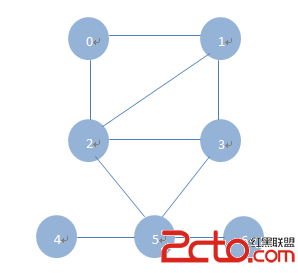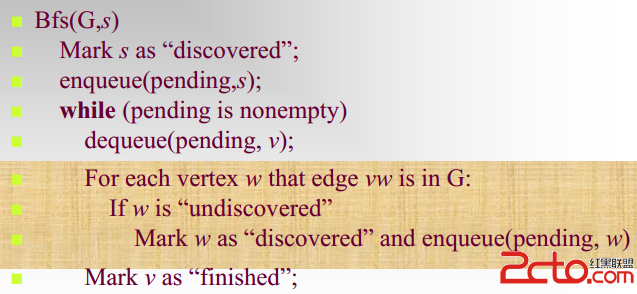這裡記錄一下無向圖的廣度優先遍歷,無向圖用鄰接表表示,使用的圖的示例圖如下,關於圖的表示可以參照博客:無向圖的表示:鄰接矩陣和鄰接表,這裡不再贅述,無向圖的表示的代碼被封裝到頭文件queue.h 中。
另外還涉及到C語言的隊列問題,可以參照博客:C 循環隊列實現,同樣不再贅述,循環隊列實現的代碼被封裝到頭文件graph_represent.h 中。
程序使用示例圖:

實現要點:
每個定點有三個狀態,-1,0,1,-1:表示未發現的節點;0:表示已經發現但是還沒有處理的節點;1:表示已經處理的節點。在遍歷過程中同樣保存了“樹邊(tree edge)”,樹邊表示在遍歷過程中經歷過的點。
程序框架如下:

代碼如下:
#include
#include
#include "queue.h"
#include "graph_represent.h"
void BFS(struct vNode** adj,int n,int s,int* parent){
int* color = (int*)malloc(sizeof(int)*(n)); //-1:未發現,0:已發現,未處理, 1:已經處理
int i;
Queue* pending = createQue(n); //創建隊列
for(i=0;ivalue]==-1){
color[w->value] = 0;
add(pending,w->value);
parent[w->value] = v;/**在這裡處理樹邊**/
}
w = w->next;
}
printf("%d ",v);/**在這裡處理節點**/
color[v] = 1;
}
printf("\n");
}
void main(){
//獲得默認圖,一共有7個節點
int n = 7;
struct vNode** adjVertics = default_wraper();
int* parent = (int*)malloc(sizeof(int)*n);
printf("\nbreadth first search:\n");
BFS(adjVertics,n,2,parent);//從第二個節點開始遍歷
}
從第二個節點開始遍歷,輸出為:2 0 1 3 5 4 6